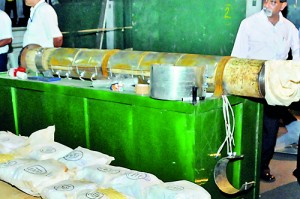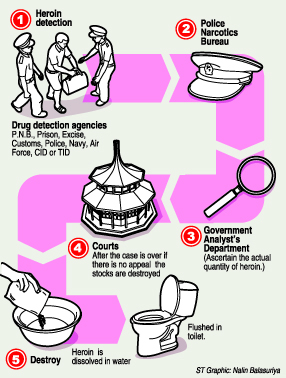News
Red alert as corruption, addiction feed tidal wave of heroin
Heroin smuggling into Sri Lanka is reaching unprecedented proportions as agencies tasked to combat the menace are struggling to combat it, an investigation by the Sunday Times has revealed.

The Rs. 700 million worth of drugs hidden inside three plastic moulding machines that was seized in an Orugodawatta container yard
It was only this week that 93.76kg of heroin with a market value of more than Rs. 700 million was seized in an Orugodawatta container yard. The drugs were hidden inside three plastic moulding machines that had come in from Karachi.
The container was assigned to the High Risk Cargo unit of the Customs for examinations by the Screening Unit on July 18 but the examination was put off until Monday after initial examinations the Customs officers felt suspicious of the consignment.
“The machine appeared not to be in working condition. It appeared to be junk. This raised suspicion, especially because it came from Pakistan,” said Upali Darmawardana, Superintendent of Customs involved in the detection.
Events that followed compounded the suspicion of the Customs officers.
“The documents were also suspicious. When we identified that the goods came from Pakistan, we were extra careful as the country belongs to Drug Triangle,” said Mr. Dharmawardana.
“The other thing was that the invoice was all printed except for one place where they had entered the number by pen. That too was noted,” Dharmawardana explained.
“They had written ‘Mali Ban Street’ not Maliban Street. So I asked the person who came to clear the goods, where is this Mali Ban Street?”
The machines were stored in the container in a manner blocking examiners access for a detailed investigation. Upon surface examination the officers observed shoddy welding work done on the machine.
“The biggest suspicion came when I checked the machine. The feeding container where the “polythene balls” (raw material polythene) are fed had been removed previously and reattached. The opening where the raw material is fed to the machine was sealed.”
“There was a lot of welding work done and it was shoddy, similar to what a welding ‘basunnehe’ (welding mechanic) in the village would do. There should be a better finish when it is a machine, but there was none of that here,” said Mr. Dharmawardana.
The team made a decision to unload and dismantle the machines to conduct a “100 per cent thorough search” with the help of the Customs Anti-Narcotics unit.
 “However this decision was met with objections by the individual who had come to clear the goods from the custom,” he said.
“However this decision was met with objections by the individual who had come to clear the goods from the custom,” he said.
Seidu Abdul Razak, the person who came to clear the machines from Customs, told the Customs officers that the machine was of “high value” and was very sensitive and Customs should bear the costs incurred for damages.
After being told that the team was going to dismantle the machine, Razak tried his best to discourage them.
“When he was told to bring mechanics, he said they would have to come from Gampola. When he was advised to hire two from Panchikawatta, he was reluctant. Finally the Customs officers stepped in and employed the services of two mechanics from the Orugodawatta yard to dismantle the machine,” Mr. Dharmawardana said.
“But even after removing all the screws on it, it did not come apart as it was welded together. This reinforced our suspicions, and it was after the machine was completely dismantled and examined that we were able to uncover the heroin,” Mr. Dharmawardana said.
Three wharf clerks and a representative from the company clearing the goods were present during the investigations. So far, only the importer from Colombo, identified as Mohamed Razik Mohamed Imran (44) and Seidu Abdul Razak (47), from Gampola, are currently in police custody.
On August 30 last year, Customs seized the largest ever haul of heroin to be busted in South Asia – 261kg of the drug.
With a street value of Rs. 2.8 billion the illegal consignment was detected in a container carrying plastic goods from Pakistan.
Prime Minister D.M. Jayaratne’s Co-ordinating Secretary Keerthi Sri Weerasinghe had issued a letter to the customs requesting them to clear the container. No legal action was taken against the secretary and the investigations have been at a standstill.
This year alone so far, 232kg of heroin has been detected by the Customs, police, Excise Department and the Prisons Department. The bulk of the detections – 130kg – was detected by the Customs, followed by the police who detected 101kg.
More than 12,000 persons have been arrested this year to date for heroin-related cases while a similar number of cases are pending. Last year, 351kg of heroin was detected and some 23,000 persons were arrested. In 2012, only 33kg of heroin was detected.
The narcotics business is lucrative, with a kilo of heroin (brown) fetching Rs. 8m. Pure heroin (white) is more expensive, but only a small quantity is smuggled into the country.
Most of the heroin is smuggled into the country from Pakistan and Dubai with smaller amounts coming in from Thailand, Malaysia and India as well, an officer attached to the Police Narcotics Bureau said.
“Colombo, Negombo, Puttalam, Chilaw, Moratuwa, Hikkaduwa, Galle and Matara are among the areas where the drug distribution takes place,” the officer said.
Police have arrested 12 main drug dealers in recent years and all their property and money has been confiscated under the money laundering act.
“One of the mysteries is that how such a large quantity of drugs is smuggled into the country. Although initially it was believed that stocks were coming in boats, now we think that most of the stocks are coming in containers,” the officer said.
According to the National Dangerous Drugs Control Board latest reports (2012) the estimated street-level supply of heroin is 763kg a year which amounts to 2kg a day – a day’s supply for 45,000 dependents.
The drug trade has fostered a high number of dependents, particularly in Colombo and its suburbs.
A resident in Dematagoda, Vinodh* (name changed to protect identity) makes his living through drug sales. A bachelor of 28 years, he says he gets his supplies from “traders” who visit him.
“They use luxury vehicles to make the distribution as they go unchecked when they use such vehicles. They ask me what quantity of heroin I could sell and supply me accordingly,” he told the Sunday Times.
“They are willing to provide me with up to 1kg. But I cannot sell large quantities. Most of the time I take 20-30 grams to sell. However this brings me big money as each of the packets to be sold contains only about 90mg. If I buy 20g I can make up about 220 packets and each of them are sold for Rs. 900-1,000.”
His job is risky as the police is on high alert, Vinodh says. To avoid detection he does not remain in one “sales location” for more than two hours.
“Thereafter another colleague takes over and sells from a different location. The regular users are well aware of the locations where they can buy their ‘shots’.
“The persons who supply us with the drugs are strict with collecting the money. If we cannot sell the drugs we have to return the remaining stocks.”
Some of Vinodh’s customers are of schoolgoing age. They are always introduced by old boys of the same school, he says.
Though there are a high number of drug dependents only about 1,100 sought treatment from the treatment centres of the NDDCB. (See box for story of drug addict.)
Drug dependency is fuelling crime. On Monday, a team from the Kotahena police arrested a person at Jampettah Street. The man was arrested as he was loitering suspiciously near the Ratnam Park.
“We found that he was removing parts from three-wheelers. Upon further investigations We found that he was a drug addict who was involved in stealing parts of vehicles in order to ensure that he gets sufficient money to buy drugs,” the Officer in Charge of the Kotahena Police, Inspector Hemantha Ovitigama, said.
| Drugs destroyed by flushing down toilet
A senior officer of the Police Narcotics Bureau said that heroin detected by various agencies including the Customs is handed over to the bureau. Hauls this year top Rs. 1000m First time free, then hooked for life Suneth * (name changed to protect identity) was offered free heroin the first time, he said. A friend introduced him to the drug. |

